EUROPARC Podcast: Young people involved in nature restoration
In this podcast, EUROPARC’s Youth Officer, Jessica Micklem-Kolenic interviews three young people involved in Nature Restoration: Livia Wright from the North York Moors National Park Young Rangers and Youth Voice Committee, Søren Thomsen from the European Young Rewilders, and Giulia Testa from the youth coalition which led the youth advocacy efforts on the EU Nature Restoration Law. Listen to their experiences in the episode below
Green-Care project scientific study confirms: mindfulness exercises in nature benefit depressive patients
© Daniel Krebs, Weisbach
A year ago, EUROPARC organised the webinar “Ways to Wellbeing in Nature – Activating Parks and Protected Areas as natural health centres”. We focused on mental health initiatives and dived into experiences from Parks and Protected Areas in our network. The scientific results of the pilot project “Green Care | Nature & Mental Health” are now available in English!
____________________________________________________________________________________________________________
Last December, the German Biosphere Region Berchtesgadener Land, together with the Biosphere Reserve Rhön (Bavarian part) were in the last phase of the Green-Care project. Here, nature-based mindfulness training was tested to support hospitalised patients suffering from several mental health conditions (e.g. depression, burn-out) to discover nature as a resource for their own everyday life. In parallel, courses for prevention purposes were organised for the local residents.
The project was accompanied by a scientific monitoring study (December 2019 – April 2023) from the Catholic University of Eichstätt-Ingolstadt, which released the final report in German earlier this year. We are pleased to also share with you the English version!
For years, the number of people who suffer from depression or anxiety disorders has increased all over Europe, including in Germany. According to the German Psychotherapeutic Association (2021) with the onset of the COVID-19 pandemic, mental stress increased steadily. Despite a dense network of treatment options for mental illnesses, patients have to wait an average of 19.9 weeks for a therapy spot (Bundespsychotherapeutenkammer, 2018). The associated sick days, sickness absence, and reduced productivity are not only an individual burden for patients but also have a huge socio-economic impact on society.
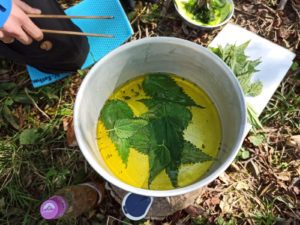
© Christoph Rothmayr, Brennnesselchips
During the project period, the effectiveness of selected mindfulness and relaxation-based nature interventions (“Greencare”) as a supplement to psychosomatic rehabilitation treatment for depressive patients was investigated (case study page). A group of healthy individuals were also offered the mindfulness-based intervention. Treatments were compared to waitlist control groups. In the clinical setting, control groups received treatment in addition to the waitlist.
The results of the scientific research show that both patients with depression from rehabilitation clinics and healthy individuals from the general population seeking preventive measures for stress reduction benefited from the offered mindfulness and relaxation activities in nature. In the clinical setting, patients with higher levels of depression on admission benefited most from the group offerings. Analysis of the questionnaires showed that nature activities enhanced positivity and feelings perceived as stressful were alleviated through the sessions.
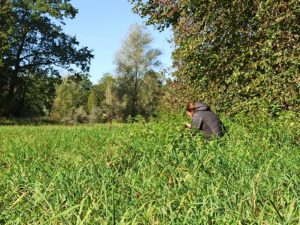
© Annemarie Rohrmaier, Pflanzenbegegnung
This effect was still measurable three months after the group sessions, suggesting that the activities were integrated into the participants’ daily lives and had a positive and lasting effect.
One major reason is that different types of activities can be carried out in various natural and cultural landscapes. Practicing the activities in remote forest areas, smaller urban green spaces, wooded areas, and meadows has proved feasible and effective.
The results also indicate that the emotional connectedness to nature, which is a crucial prerequisite for the willingness to engage in nature conservation, increased as a result of the sessions.
The study demonstrated that the innovative offerings provided have been effective.
Forests for Individual and Public Health – Research body and praxis from Italy
Forest bathing session in "Fonte del Borbotto", Florence Province. Photo Archive of Italian Alpine Club
Forest therapy represents the most important “nature-based programme” for health improvement. Since 2019 extensive research has been conducted in Italy to establish scientific criteria and a methodology to develop Forest therapy initiatives across the country.
Our long standing member Italian National Research Council and the Italian Alpin Club were the initiators.
______________________________________________________________________________________________________________
This expert article was drafted by Federica Zabini (Institute of Bioeconomy, National Research Council of Italy – CNR-IBE – Florence) and Francesco Meneguzzo (CNR-IBE and Central Scientific Committee, Italian Alpine Club, Milan).
Global research on the restorative and healing effects of forest environments has expanded in the last decades, with a strong acceleration since the mid-2010s. If progressive urbanisation and consequent nature deprivation appear as the root causes of such an interest, the combination of aging, growing burden of public healthcare expenditures, and increasing concerns for the stability of the global economy have strongly motivated the turning towards natural medicine resources.
Forest immersion to boost human health was a practice in the Far East (i.e. Japan and South Korea). In 1982, the Japanese national Forest Agency introduced a national health programme of forest immersion (Shinrin-yoku) to reduce stress in the workforce. Later, in 2004 a comprehensive research project to investigate the scientific evidence on the healing effects of forest immersion on human health began.
The interest of the international research community gained momentum since 2016 along with Nature Based Interventions. Later and following the COVID-19 pandemic [1] the UN the recognised forest therapy benefits as a tool for green recovery [2].
A growing body of evidence shows the relevance of nature experience and “green care”. Also, exposure to forest settings has been rigorously linked to both psychological and physiological health benefits.
Forest therapy and related mechanisms
Forest therapy, often named also “forest bathing”, represents the most important “nature-based programme” dedicated to health improvement in the strict sense. Forest therapy initiatives are now spreading globally and resulting in a great diversity of activities.
However, to date, with the exception of Japan, South Korea, and more recently China, these local-level initiatives are largely not embedded in institutional frameworks, from the choice of suitable sites to other elements allowing the achievement of desired health outcomes.
What are the conditions and features of a forest therapy trail allowing to achieve statistically significant health outcomes and thus potentially the incorporation into official clinical treatments?
Forest therapy engagements take place via slow walks along forest trails that facilitate multi-sensory, immersive experiences. Beneficial effects of forest therapy derive from the combined stimulation of all senses, induced by specific features of the natural environment.
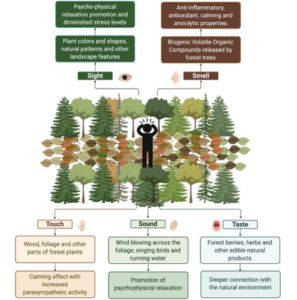
Sensory components of forest bathing and their effects on individual well-being.
Image from: Antonelli M, Donelli D, Carlone L, Maggini V, Firenzuoli F & Bedeschi E (2022) Effects of forest bathing (shinrin-yoku) on individual well-being: an umbrella review, International Journal of Environmental Health Research, 32:8, 1842-1867, DOI: 10.1080/09603123.2021.1919293
Disentangling the contribution of single stimuli to the observed effects on human health is hard, due to many confounding factors, either environmental or personal, with stimuli often acting synergically.
Several studies showed that the main factors positively affecting the restorative and relaxation effects of the immersion in forest environments are:
- Naturalness: natural, wild, and uncontaminated forests, with large, old trees, overcoming urban and commercial forests;
- Biodiversity: diverse vegetation communities, high species richness and abundance, native species, vegetation density;
- Forestry structures: easily accessible, open and bright environments;
- Presence of water (e.g. waterfalls, streams);
- Distant view of scenic landscapes (e.g., mountains);
- “Environmental coherence“: the absence of disturbing factors (e.g. plantations, artificial sounds, poorly integrated infrastructure)
Evidence-based standard for a European forest therapy service system – an experience from Italy
Among other contributing factors, the inhalation of biogenic volatile organic compounds (BVOCs) emitted by plants and soil into the forest atmosphere, particularly monoterpenes (MTs), have been suggested as one of the determinants of the health benefits of forest immersion experiences.
The identification of suitable sites to build a networked forest therapy service system requires the consideration of the characteristics of forest sites and trails, and to substantiate the ongoing spreading of forest therapy practices by adopting recognized, evidence-based standards, for the acceptance of forest therapy as a part of officially recognized medical treatments.
In Italy, the effort to establish scientific criteria and a methodology to develop Forest therapy initiatives started in 2019, with a joint project between the Italian Alpine Club (CAI) and the National Research Council of Italy (CNR), which expanded since 2021 to the Italian Ministry of Agricultural, Food and Forestry Policies, CREA (Council for agricultural research and analysis of agricultural economics), Italian National Institute of Health (ISS), and few Italian University Departments.
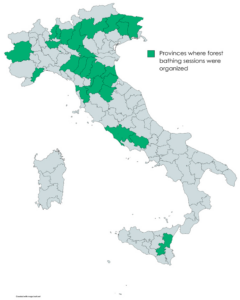
Source: Antonelli, M.; Donelli, D.; Maggini, V.; Gallo, E.; Mascherini, V.; Firenzuoli, F.; Gavazzi, G.; Zabini, F.; Venturelli, E.; Margheritini, G.; et al. Demographic, Psychosocial, and Lifestyle-Related Characteristics of Forest Therapy Participants in Italy: A Multicenter Cross-Sectional Survey. Healthcare 2023, 11, 1627. https://doi.org/10.3390/healthcare11111627
The participants engaged in a forest therapy session guided by psychologists or psychotherapists following a standardized protocol, lasting approximately 2.5 hours. The session involved slow walking of short duration, with pauses of 15 minutes at five different spots. At each stop, individuals were encouraged to focus on one sense (visual, auditory, tactile, olfactory perception). The protocol includes a 20-minute stop for free immersive activity.
A very extensive campaign was arranged between June 2021 and October 2022, at 39 forest sites across Italy, including mountain, hill, and urban park settings, with more than 1300 adults participating to standardized forest therapy experiences [3].
The large database built upon such campaign allowed to achieve important and original results. For the first time, it was shown that the inhalation of plant-emitted MTs, and in particular α-pinene, produced a specific, dose-dependent anxiolytic effect, independent of any other factor. About 30% of the overall reduction in anxiety symptoms achieved after 2.5-hours of forest therapy sessions in environments endowed with above-the-average MTs concentration, were attributable to the exposure to MTs themselves, with a significant dose-dependent size of the anxiolytic effect [4].
Another study, performed in cooperation with the “Pio XII Institute” Altitude Pediatric Asthma Center at Lake Misurina, eastern Italian Alps, found statistically significant associations between the quantity of monoterpenes inhaled by asthmatic adolescents admitted to the rehabilitation camp and the improvement of their respiratory functions, according to several different measures; such an effect was related to the benefits on the patency of the small airways [5].
These results allowed to define the direct therapeutic role offered by the exposure to forest settings with regards to anxiety and asthma symptoms, and to identify the direct dependence of the health effects on the dose of inhaled monoterpenes.
Moreover, the same results allowed to define some objective criteria for identifying Forest Therapy stations capable of providing clinical level services and assign a specific therapeutic value to each forest and nature site, depending on plant species, extension of forest stands, altitude, climate, and conditions on the season and the period of the day.
Forasmuch as the economic value of protected natural areas, assessed based on the improvement of the mental health of visitors, amounts to about 6% of global gross domestic product (GDP) [6,7], and that anxiety imbalances have been associated with a 52 % increased risk of cardiovascular diseases (CVD), independently of any other risk factors [8,9], any effort aimed at increasing the ecosystem functions and services of natural and protected areas towards human mental and physiological health, including conservation and protection of biodiversity, is widely justified based on benefits to both individual health and public healthcare budgets.
Shifting Baseline Syndrome, impacts on nature conservation and prevention – Margaux Pierrel
Margaux Pierrel beside an old oak tree at the heart of Knepp (UK).
Margaux Pierrel is one of the 2022 Alfred Toepfer Scholarship winners. In this article, she details what she’s learned about Shifting Baseline Syndrome during her study trips. You can find her full report at the end of this article.
Article issued by Margaux Pierrel
About shifting baseline syndrome

Marsh harrier at Wild Ken Hill (UK) © Margaux Pierrel
Shifting baseline syndrome (SBS) is a psychological and sociological phenomenon describing a gradual change in the accepted norms for the state of nature due to a lack of memory, knowledge or experience of its past condition. In other words, SBS is the situation in which each new generation consider the state of nature when they were born and raised as the normal or healthy baseline. As a dual climate and biodiversity crisis unfolds, this results in a continual lowering of people’s accepted thresholds for the ‘normal’ state of nature.
SBS is therefore an aggravating factor to the environmental deterioration and decline of species; as well as one of the major obstacles to nature protection and climate justice.
Presently working as a conservation ranger in Ireland, I face the consequences of SBS in my daily activities, from law enforcement to site monitoring, through environmental education. Thanks to the Alfred Toepfer Natural Heritage Scholarship, I was able to learn more about the implications of SBS on nature conservation in European protected areas, with the objective of understanding better this relatively unknown phenomenon and how it affects the professional sector.
In order to do so, I carried out five study visits in European protected areas in 2023. The visited sites were Wild Ken Hill (UK), Oostvaardersplassen Nature Reserve (Netherlands), Knepp (UK), Mercantour National Park (France) and Rewilding Rhodopes (Bulgaria).
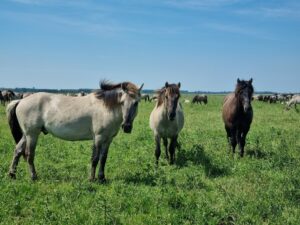
Konik horses at Oostvaardersplassen Nature Reserve (Netherlands), Margaux Pierrel
Why should SBS be considered in conservation?
As developed in my report, there are three main causes of SBS:
- the lack of scientific data on past conditions,
- the extinction of experience (i.e. lack of interaction and orientation for nature),
- the loss of familiarity with nature, leading to people’s incapacity to assess an environment and thus notice change.
SBS has several consequences, of which some are aggravating factors of SBS (i.e. ‘feedback loops’). These include a gradual habituation to degraded natural environments and altered expectations for the state of nature (i.e. what is worth protecting or not).
The professional sector of ecology and conservation is not exempted from these consequences, and other implications can develop such as ‘conservation complacency’ where policymakers may set inappropriate or less ambitious targets for environmental conservation, restoration and management programs due to false perceptions of past environmental conditions. SBS can also result in a lack of consideration for alternative historical data, leading to a knowledge loss from generation to generation.
Suggestions on how to prevent SBS and reverse the shift

Bison reintroduction in Rewilding Rhodopes (Bulgaria), Margaux Pierrel
Thanks to research and interviews with experts during my study visits, I have highlighted four suggestions or ‘treatments’ against SBS:
- Reversing SBS must pass through the restoration of the natural environment and rewilding, where conditions allow.
- A (re)connection with the natural environment should be encouraged by and for everyone, since tuning in with nature will enable people to start noticing change again, therefore giving people a sense of belonging and the wish to protect what they know.
- Access to robust monitoring data should be made available for all professionals, this data should be saved on a safe and accessible interface and should be used to inform conservation objectives and strategic plans for protected areas.
- An emphasis should be given to environmental education, for all age groups, and across rural and urban areas, as well as designated for professionals thanks to workshops and partnerships.
This Alfred Toepfer Natural Heritage Scholarship offered a fantastic opportunity to expand my knowledge and experience of Shifting Baseline Syndrome and its effects on European nature conservation. I am grateful for the possibilities to network and to travel to inspiring protected areas, it will greatly benefit my professional career, and hopefully those of others.

The Alfred Toepfer Natural Heritage Scholarship is made possible thanks to the generous support of the Alfred Toepfer Stiftung.